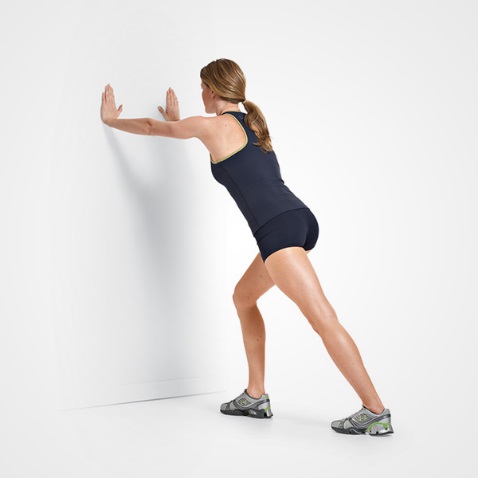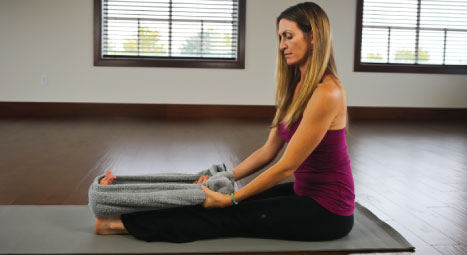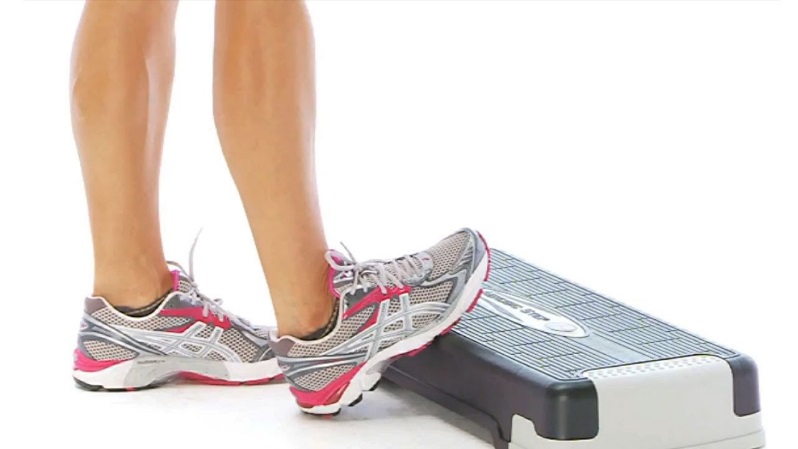If you are experiencing soreness in the heel of your foot, you may be suffering from plantar fasciitis. It can be quite painful as this is an area of your foot that you use quite often. The plantar fascia is the thin ligament that supports your arch and connects the front of your foot to the back of it. It can get damaged or strained by weight gain, repetitive exercise like running or a tear from stepping wrong. However, there are techniques and exercises that can help relieve the pain and discomfort.
Exercises for Plantar Fasciitis
When you are suffering from plantar fasciitis, one of the best ways to relieve discomfort is stretching your feet. The worst thing for the condition is tight muscles. Often, athletes will over train and injure this area. There are several stretches for plantar fasciitis you can do yourself at home, such as:
1. Calf Stretch

- Place your left foot in behind your right foot.
- Slowly bend your right leg frontward.
- Make sure your left heel stays on the ground and the knee kept straight.
- Hold position for 20-30 seconds, but not longer.
- Release and then repeat.
- Do a total of 4 repetitions, and then switch legs.
2. Big Toe Stretch
- Sit down, sit up straight, and cross you right leg over your left.
- Grab the big toe on the upper leg and very gently pull it upwards and towards the ceiling.
- Hold this stretch for 20-30 seconds. Repeat 3 times.
- Change legs and repeat.
Another simple exercise that will strengthen the area without too much stress is scrunching a towel with toes of the injured foot. You can get the same outcome by picking up dice or pencils with your toes.
3. Towel Stretch

- Sit on the floor with legs together, front facing.
- Fold a towel longwise.
- Place the towel around both feet at the arches.
- Slowly and gently, use both hands to pull the towel towards you, stretching your feet.
- Hold for 20-30 seconds, repeating a total of 4 times.
4. Soleus Stretch
One of the most effective exercises for plantar fasciitis is the soleus stretch.
- Stand facing a wall with one foot forward.
- The foot needing the stretch should be placed behind the body.
- As you lean against a sturdy object or wall, press the heel of back leg to the floor.
- You can increase the intensity of the stretch slowly over time by pushing the front leg knee towards the wall.
- Hold stretch 20-30 seconds, repeating 3-4 times.
5. Step Stretch

- Place an exercise step or slightly elevated platform in front of you.
- Place the toes of the injured foot on the step.
- Gently lower the heel of the foot until it touches the ground, keeping your toes on the step.
- Stand next to a wall or something sturdy to lean on if needed.
- Hold stretch for 20 seconds and repeat 3-4 times.
6. Ball Stretch
One of the effective stretches and exercises for plantar fasciitis is the ball stretch. Simply put a tennis ball or a ball of similar size on the floor. Place the foot that needs to be stretched on top of it. Roll the ball under the foot and heel to gently loosen the muscles and tension. If tolerable, press harder to add pressure to massage deeply into foot. Stop if it causes pain. Continue for 10-15 minutes.
NOTE: Similar to the ball stretch, you place a frozen bottle of water under the foot that needs stretching.
Take It Slow
Take a Break from Exercise
It is hard to slow down when you are used to exercising on a regular basis. However, sometimes the best exercise for plantar fasciitis is no exercise at all. When your ligament and heel are injured, they need time to heal. If you are a runner, this means stopping for a little while. During the break, you can continue to do stretches. Sometimes, ibuprofen or other anti-inflammatory drugs can help.
Return to Exercise Slowly
Once the ligament in your foot is healed, you can slowly add exercise back into your routine. The most important aspect of exercises for plantar fasciitis is to start with short distances. Begin by walking, then jogging and slowly return to your normal running regime. Always start and end with stretches. As soon as you feel pain or discomfort, stop. You do not want to permanently damage the area.
